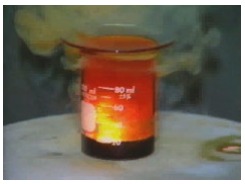





A redox reaction is a chemical reaction in which the electronic structures (and therefore the structure of ions and molecules) are modified.

Aluminium $Al(s)$ pieces are added to pure bromine $Br_2(l)$: A violent reaction occurs. $2Al$ $+$ $3Br_2$ $\longrightarrow$ $2AlBr_3(s)$ Aluminium bromide $Al^{3+}(Br^-)_3$, a ionic white solid is produced: $Al$ $-$ $3e^-$ $\longrightarrow$ $Al^{3+}$ (1) $Br_2$ $+$ $2e^-$ $\longrightarrow$ $2Br^-$ (2) (1) Each metallic neutral aluminum atom $Al$ looses electrons from its outer layer to be transformed to an aluminium cation $Al^{3+}$. It is said to be oxidised. (2) Each neutral bromine molecule $Br_2$ gains electrons in order to complete the outer layer of its two atoms which are so transformed to bromide ions. It is said to be reduced. (1) and (2) are called partial equations or redox half reactions.
The electrons caught by the bromine molecule are taken from the aluminium atom.
For these electrons to be equilibrated in number, 3 molecules of bromine must react with 2 atoms of aluminium:
$Al$ $-$ $3e^-$ $\longrightarrow$ $Al^{3+}$ | $\cdot 2$
$Br_2$ $+$ $2e^-$ $\longrightarrow$ $2Br^-$ | $\cdot3$
 $2Al$ $+$ $3Br_2$ $\longrightarrow$ $2Al^{3+}(Br^-)_3$ (3)
(3) is an equation for the simultaneous oxidation of aluminium and reduction of bromine.
It is called oxidation-reduction (redox) reaction.
Aluminium $Al^{3+}$ and bromide $Br^-$ ions are attracted mutually (ratio 2 to 3) to form the ionic solid called aluminium bromide $Al^{3+}(Br^-)_3$
$2Al$ $+$ $3Br_2$ $\longrightarrow$ $2Al^{3+}(Br^-)_3$ (3)
(3) is an equation for the simultaneous oxidation of aluminium and reduction of bromine.
It is called oxidation-reduction (redox) reaction.
Aluminium $Al^{3+}$ and bromide $Br^-$ ions are attracted mutually (ratio 2 to 3) to form the ionic solid called aluminium bromide $Al^{3+}(Br^-)_3$
- A species which looses electrons is oxidised (here:$Al$). - A species which gains electrons is reduced (here:$Br_2$). - A species which gives away electrons is a reductant (reducing agent) (here:$Al$). - A species which takes electrons is an oxidant (oxidising agent) (here:$Br_2$). - A species which gives electrons to another species reduces this species (here:$Al$ reduces $Br_2$). - A species which takes electrons from another species oxidises this species (here:$Br_2$ oxidises $Al$).
$Mg$ $-$ $2e^-$ $\longrightarrow$ $Mg^{2+}$ | $\cdot 2$ (1)
$O_2$ $+$ $4e^-$ $\longrightarrow$ $2O^{2-}$ (2)
 $2Mg$ $ +$ $O_2$ $\longrightarrow$ $2Mg^{2+}O^{2-}$ (3)
- (1) is an oxidation half-reaction.
Magnesium is oxidised to magnesium ion.
It is a reductant.
- (2) is a reduction half-reaction.
Oxygen is reduced to oxyde ion.
It is an oxidant.
- (3) is an oxidation-reduction (redox) reaction.
Magnesium is oxidised by oxygen. Magnesium is a reductant which reduces oxygen.
The product of this reaction is the white ionic solid magnesium oxide:
$Mg^{2+}O^{2-}$.
$2Mg$ $ +$ $O_2$ $\longrightarrow$ $2Mg^{2+}O^{2-}$ (3)
- (1) is an oxidation half-reaction.
Magnesium is oxidised to magnesium ion.
It is a reductant.
- (2) is a reduction half-reaction.
Oxygen is reduced to oxyde ion.
It is an oxidant.
- (3) is an oxidation-reduction (redox) reaction.
Magnesium is oxidised by oxygen. Magnesium is a reductant which reduces oxygen.
The product of this reaction is the white ionic solid magnesium oxide:
$Mg^{2+}O^{2-}$.